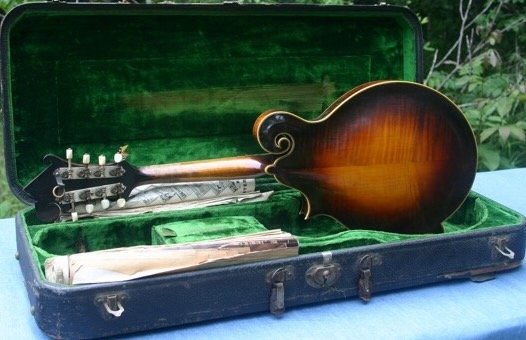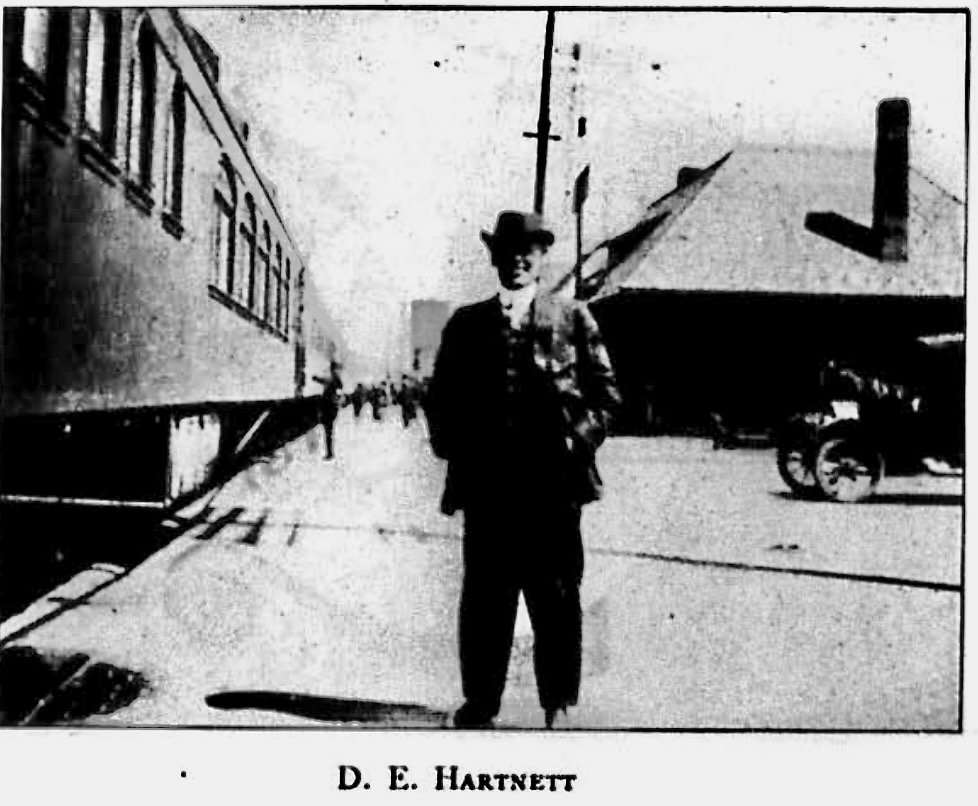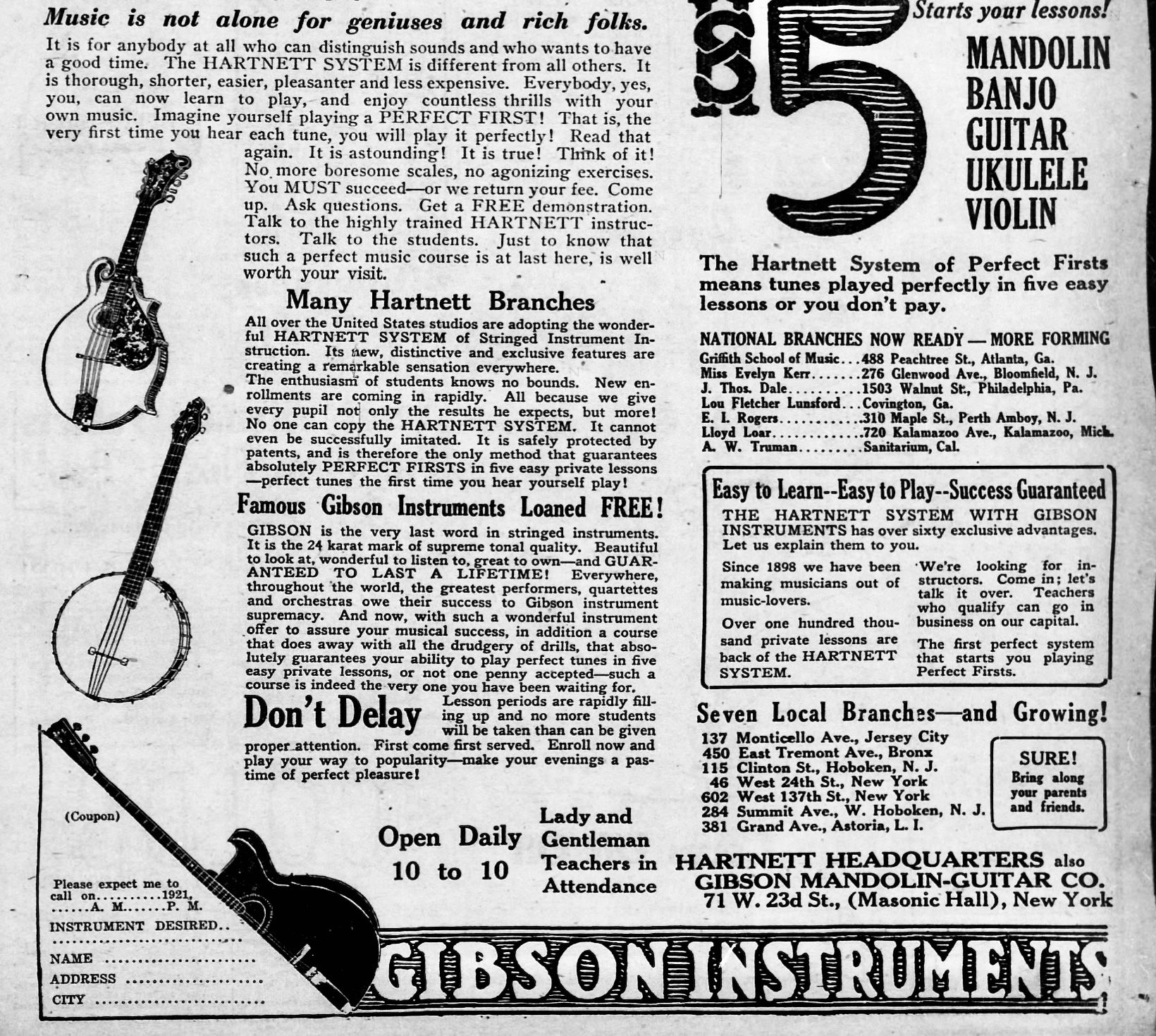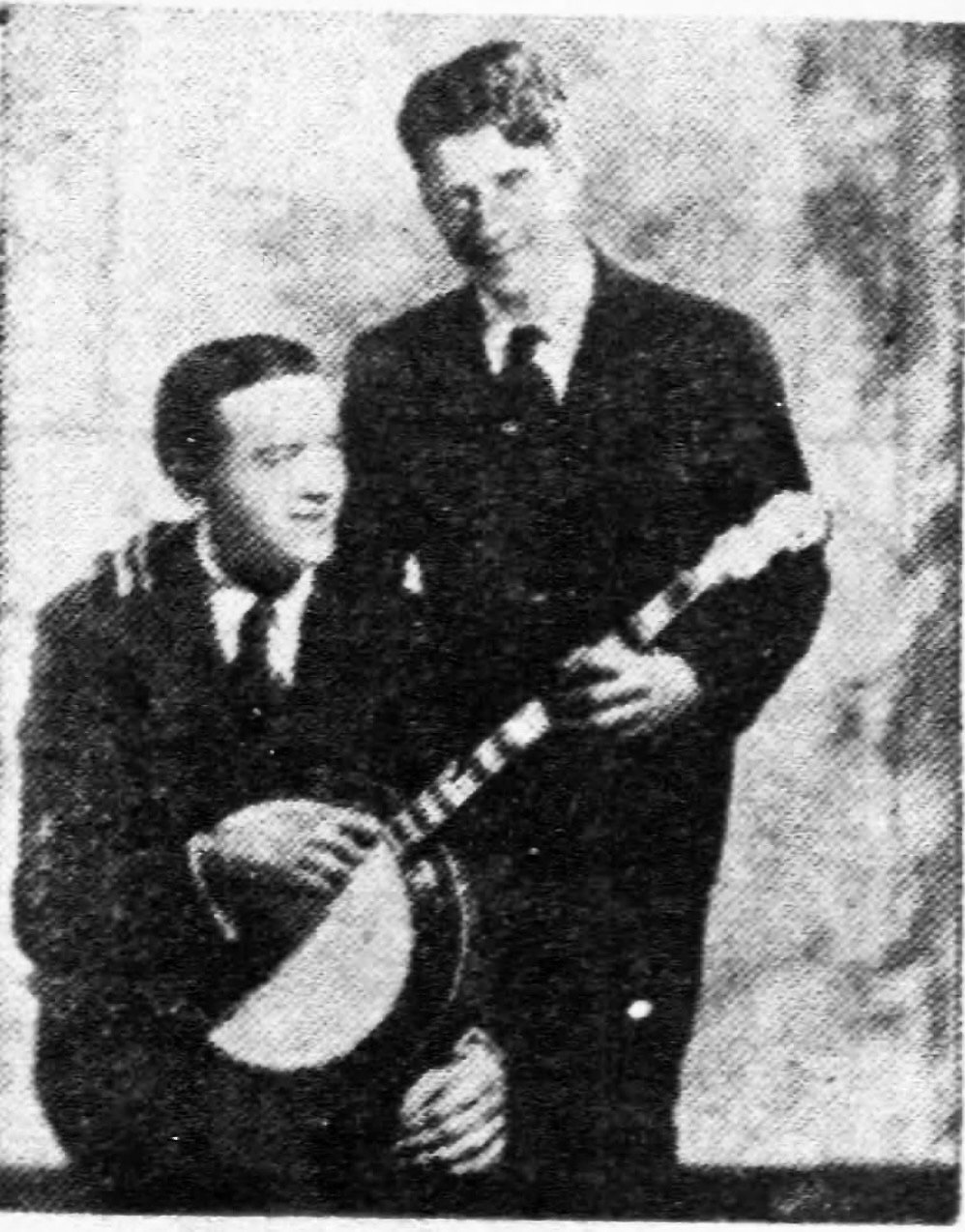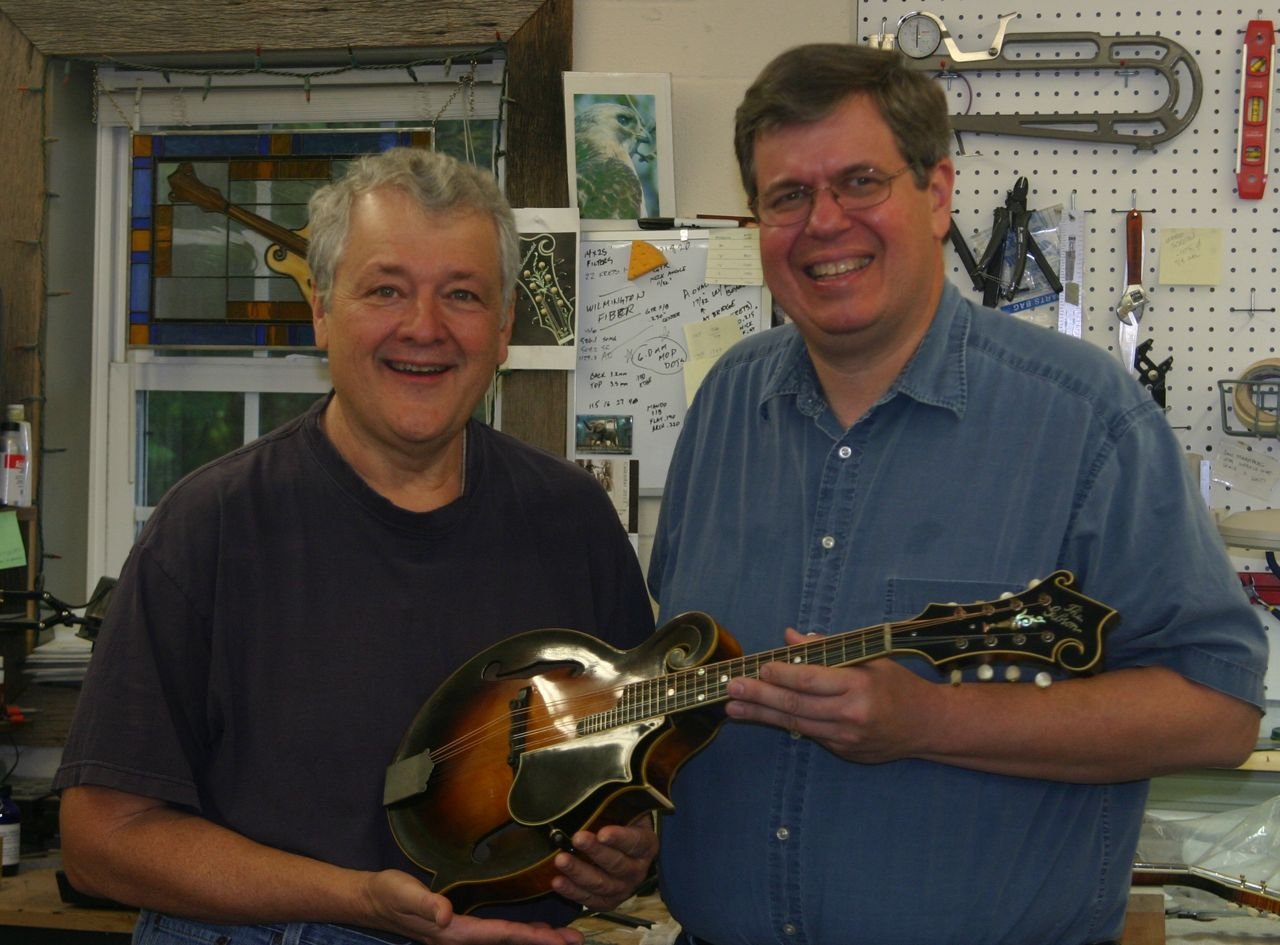An attic in Illinois. A rectangular black case, closed since 1962. The case opened. The “Holy Grail!” A 1923 Gibson F-5! A familiar aroma lit up my senses: The unmistakeable sniff of Loar varnish, but it was clouded by countless nights of music, smoke, beer and laughter. I thought, this man, like Lloyd Loar himself, must have enjoyed a good cigar! Rolled up music crowded around the mandolin, titles like “Golden Slippers,” “Bully Of The Town,” “The Bells of Saint Mary.” Photos and notes, a set-list. These were the clues that allowed us to trace the story of this incredible mandolin that had been delivered, in 1923, to the man who played it for 40 years. He will be one of three musicians profiled in this episode, the “Class of ‘23.”
We know of 139 Master Model instruments that were produced and signed by Lloyd Loar by September 1 of 1923. Based on our examination of photographs, letters, documents and publications, we have identified 57 musicians who acquired those instruments new. Some were well-known professionals, like Dave Apollon, C. C. Rowden, Clyde Doerr and Loretta Tabaka; many were artist/teacher/agents like William Griffith, Marguerite Lavery and T. A. Miles, who not only received their personal F5s, but populated their area with countless Gibson instruments. Some were entrepreneurs, like Dennis E. Hartnett of New York City, who promoted “all things Loar” through his chain of stores, the “National Music Studios.” Some, like immigrant Loreto Chichiarelli, simply wanted the greatest happiness possible during a difficult time of life. By far, most were like Clarence Bass of Peoria, who did not play outside his home town. In fact, we only know his story from the memorabilia left in his instrument case. Considering that these local players are very difficult to trace, we think we have identified only a portion of those who acquired these mandolins in 1923 “with the smell of new varnish.” We find it reasonable to conclude that the Master Model was very well received, and, at least in the first year of production, remarkably successful. It is likely that many were sold by Gibson at wholesale prices to or through artist/teacher/agents, and it is possible that others were delivered with extended payment terms. We cannot speak to the financial welfare of the Gibson company as a result of this venture, as we have not found adequate costs/sales records, but we can conclude that any failure on the part of Gibson to be commercially successful during this time was not because the mandolin-playing public rejected the F-5. Quite the contrary, it appears that a significant number of the leaders of the mandolin community embraced the Master Models wholeheartedly and even more amateurs stepped up to make that purchase. In future installments, we hope to tell the stories of many of these musicians. In this episode, we profile Dennis Hartnett, Loreto Chichiarelli and Clarence Bass, three of the first generation of Loar owners.
During the Guild Convention in New York City in April of 1922, while Sam Siegal and Walter Kaye Bauer ducked out to a Coney Island shooting gallery to match rifle skills with Annie Oakley, Lloyd Loar and Lewis Williams paid a visit to the Masonic Hall on 71 W 23rd St where Dennis E. Hartnett had established the headquarters of the National Music Studios. Hartnett became one of the first to embrace the F5 and offer the Master Model instruments for sale in his multitude of music academies. Many of the Loar-signed instruments that surfaced in New York over the years originally came through Hartnett. In a letter to Gibson in 1923, he gushed:
This letter from Dennis Hartnett was printed in the Crescendo XVI, October, 1923 and again in the Cadenza in November.
Lloyd Loar (standing on right) and Dennis Hartnett (white hair, second from left), in NYC, April, 1922.
Dennis E. Hartnett was quite a character. Born in Catskill, New York in 1872, he, his sister Lizzie and brother Timothy were all spinners in the Greene County Textile Mill by the time they were teenagers. Not cut out for mill-work, he was often absent as he perfected his skill on a variety of musical instruments. In 1898, Hartnett moved to New York City and began teaching music in an apartment on 23rd street under the prestigious title National Music Studios. At the outbreak of the Spanish American War, he enlisted in the National Guard in Syracuse, New York on July 20, 1898. His service record began at Camp Black in Long Island, where he had multiple episodes of sick leave, noted in military records as “Absent With Leave, claimed by him and certified by physician.” Finally, he found his niche with “Special duty with band” from November 23 to January 1. Private Hartnett was assigned to Company K, 203 Infantry, and sent to Camp Wetherill in Greenville, South Carolina, where he spent the remainder of the war with “usual military duties until he was mustered out on March 25, 1890.” Unlike many other National Guard Units, he was never sent to Cuba. (He did make it to Cuba in 1915, but not to charge up San Juan Hill with Teddy Roosevelt. It is unclear whether that was a honeymoon—he had married a 44-year-old widow, Nellie Dickinson McClellan in Springfield, Massachusetts, on October 24— or an attempt to establish a National Music Studio in Havana).
After his service was over, he returned to teaching and performing in New York City. The City Directory of 1903 lists him at 120 E 23rd Street under “banjo teachers;” in 1910, “musician” (same address); 1913 “music teacher” at 46 W 24th R1521.” Hartnett, “a tireless talker,” quickly ascended into the mandolin, banjo and guitar elite of the Northeast. In 1912, he was elected president of the American Guild and, as the story goes, on the train ride to Chicago for the 1912 Convention, shared a sleeper car with Bostonians Walter Jacobs (music publisher and editor of the Cadenza) and George Lansing (veteran banjoist and author of popular banjo method books). A tongue-in-cheek article in the Cadenza described the antics of the merry travelers, which somehow resulted in a flask of so-called “Florida Water” being spilled in Hartnett’s suitcase. Hartnett blamed his sister Lizzie, whom he claimed had packed his suitcase, but “It was noticeable thereafter that, whenever promenading the car aisle after changing his socks, this ‘Old Crow’, instead of leaving behind him an aroma of the Everglades of Florida, trailed after himself a decidedly pronounced and beautiful bouquet of ‘Old Kentucky Green River’ from the ‘County of Bourbon’.” (Cadenza, June 1912).
Dennis Hartnett, stepping off the train in Chicago to attend the Guild Convention of 1912.
Upon arriving in Chicago, Hartnett’s first stop was the to instrument exhibit where he met Lewis Williams and became enthused with Gibson instruments. By 1917, he was “Manager, Gibson Mandolin and Guitar Company” in New York, with a home address of 335 E 31st St. He expanded his National Music Studios to satellite studios throughout the metropolitan area and beyond. Promoting the “Hartnett System” of music teaching, he printed slogans like “Play, Or Don’t Pay;” or “Gibson Instruments Loaned Free!” and the endearing “Play, Drive Dull Cares Away.” In 1921, Lloyd Loar was included as a master of the Hartnett System in the National Music Studios of Kalamazoo, Michigan. Like Loar, Hartnett also patented musical inventions, most famously his “Developer,” a mute system that allowed a musician to practice without disturbing family or neighbors.
Lloyd Loar and William Griffith listed in the “Hartnett System.” Daily News, New York, New York, October 20, 1921.
Advertisement in The Daily News, November 2, 1921.
The Daily News, New York, New York, October 20, 1921.
Dennis Hartnett continued a lifelong friendship with Lewis Williams and Lloyd Loar, from his advocacy of Master Model Instruments to offering Loar’s music folios to students. By 1935, National Music Studios was the New York distributor for Williams’ and Loar’s Vivi-Tone instruments. Hartnett’s Vivi-Tone mando-cello, one of the most perfectly preserved and beautiful instruments produced by that company, can be seen today at the National Music Museum at the University of South Dakota, complete with electronics and speaker.
The Daily News, New York, New York, Mar 5, 1935
Hartnett continued to manage his chain of studios well into his seventies, although, by 1940, he embraced the “Shillinger System,” a teaching method developed by Joseph Shillinger, a professor at the New School in NYC who was influential on Benny Goodman, George Gershwin and Glenn Miller. After his death in 1947, Dennis Hartnett’s 148-acre estate in Southampton, Massachusetts, was bequeathed to the New England Forestry Association, where it remains an historical and natural preserve for public enjoyment and education.
Hartnett loved to use celebrities in his advertisement; silent film star Priscilla Dean was the archetypal Gibson Girl!
Charles Peterson (with Gibson banjo) and matinée idol, Rudy Vallée pose for a National Music Studios advertisement.
Loreto Chichiarelli, immigration document dated March 14, 1914.
Seventeen-year-old Loreto Chichiarelli packed his mandolin and sailed to New York City just ahead of the horrific war that engulfed Europe. Born on December 13, 1897, in the hills overlooking the sea near Rosciolo, Italy, he grew up half way between Rome and Naples, two cities synonymous with the mandolin. Arriving in New York City on March of 1914, all his US documents list his occupation as “musician.” He was welcomed into his uncle’s family home at 216 Lookout Avenue in Butler, Pennsylvania. Thanks to Percy Lichtenfels and Russell Truit, that area was a hotbed of Gibson enthusiasts, and we suspect Chichiarelli had his first taste of the American mandolin there. Wandering minstrel that he was, he made his way to Little Italy in Chicago, after which he discovered the little town of Meredosia, Illinois, with its mussel beds and buttons factories. Continuing west, he landed a position teaching music at the Sacred Heart College in Denver, Colorado in 1917. Unfortunately, politics caught up with him even there, and he was drafted into the US army. He was mustered in at Camp Lewis in Tacoma, Washington, in 1918 and assigned to the 75th Infantry. During his time there he contracted tuberculosis. He was discharged from the US Army on January 13, 1920, 100% disabled, and was sent to the Phoenix Sanitarium in Maricopa, Arizona, where he registered (as a Democrat) to vote on June 2, 1920, before moving to a sanitarium in Fitzsimmons, Colorado. On June 30, 1920, he married his nurse, Anna Daniels, in Denver. We like to think that with Anna, he had found a modicum of happiness, which was indeed complete in the summer of 1923, when a mandolin arrived from Kalamazoo. He wrote to Gibson, “I have received my Gibson Master Model Mandolin, style F-5, and I am certainly proud to own such an instrument. It is a wonder.” Based on the timing of his letter, he would most likely have gotten a mandolin from the July 9, 1923 batch. In 1924, he and Anna moved to Tucson, and in March, he was finally granted naturalization as a US citizen. On May 18, 1925, with Anna and his mandolin by his side, he succumbed to a pulmonary hemorrhage brought on by his tuberculosis. Funeral services were held at the All Saints Church in Tuscon, and Anna accompanied his body back to Meredosia where he was laid to rest. He was only 27.
Clarence Bass, 1960, with his 1923 Gibson F-5, sharing music with a relative.
The mandolin profiled at the beginning of this episode belonged to Clarence Clifford Bass of Peoria. He was born on February 4, 1883, in Kinmundy, Illinois, just east of St. Louis, to Jasper and Adeline Crain Bass. In 1899, the Bass family moved to Lewiston, Illinois, where Clarence, at the age of sixteen, was enrolled in Lewiston High School. He entered that school at the same time as the very bright thirteen-year-old, Lloyd Loar, whose family had just moved there from Cropsey, Illinois. Loar and Bass both graduated in 1903, part of a class that totaled 19 students. Sadly, his father, Jasper Bass, was killed in an accident in 1905, and Addie Bass moved back to Kinmundy to work as a servant for another widow, Thea Charlton. Clarence, on his own, found work as a machinist for Leader Iron Works in Macon, Illinois. By 1920, his relative Cresswell V. Groat, a banker in Peoria, encouraged Bass and his wife Bessie to move to that town. There, Bass found employment as a machinist, first in tractor manufacturing and later as a “screw machine operator.” Bass spent all his free time playing mandolin, and in 1923 became the very proud owner of an F-5 signed by his Lewiston High School classmate, Lloyd Loar. According to family members, the two classmates stayed in touch, and, in 1931, Bass and Loar (who had just moved back home from Boston) were in attendance in Peoria when Loar’s younger sister, Madelon, married Cress Groat on September 12.
Signature on the Bass Loar.
When we discovered this mandolin in 2012, we took it to the internationally acclaimed luthier Lynn Dudenbostel. During the next few months, with techniques used by fine art experts, Dudenbostel removed ninety years of smoke, beer and dust that had encrusted the mandolin. When finished, he had uncovered 100% of the original varnish and shellac. No overspray or coating of any kind was needed.
Lynn Dudenbostel at his bench carefully removing grime and smoke build-up, leaving all the original finish intact.
Happy Day! The result? A beautiful, incredible sounding 1923 Gibson F-5, ready for another 100 years of great sounds!
When Lynn Dudenbostel had completed his amazing restoration, I went straight to the “Rubber Room Recording Studios” in Chapel Hill, NC, where engineer Jerry Brown recorded the following video of an arrangement I based on Clarence Bass’ music. We hope you enjoy!
Note: in writing these stories of the first generation of Loar owners, I have perused (and made copies of) thousands of primary source documents: birth, marriage and death certificates; US Census; city directories; military documents including draft cards, mustering and deployment records; immigration, arrival and departure logs; school records; University and Public Library documents; newspapers, journals, catalogs and magazines from the period; and my own library of fifty years of interviews with musicians, family and friends of that first generation. I am indebted to all those keepers of records and hope you enjoy my findings.
Next Episode, scheduled for September 20: “The Griffith School of Music”

